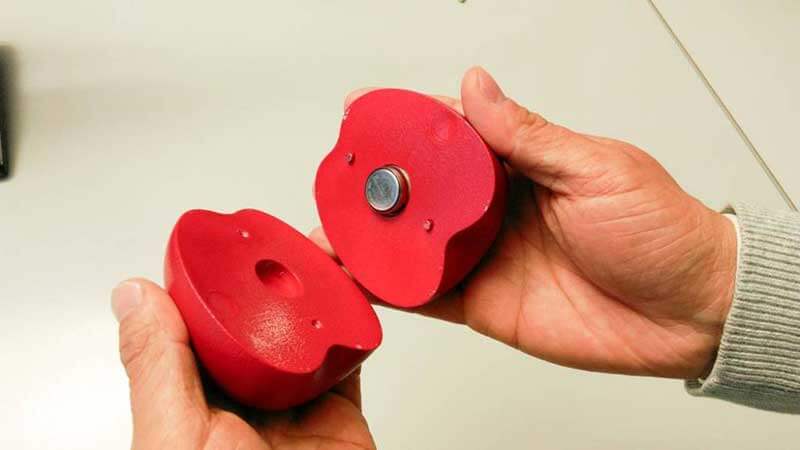- 3D-printed apple ‘spies’ on its neighbours to monitor their quality
- Transportation may no longer be the weakest link in the food supply chain
- Billions of tonnes of food wastage could soon be a thing of the past
- Paving the way for improved food safety and quality control
It’s the middle of winter and you’re craving pears. Chances are, you’ll find what you need at your local supermarket, but the product is not always what you’d expect – which you probably realise when you discover it actually tastes bland and mealy. Even though seasonal fruits and vegetables have the best ingredients and the most delicious flavours, it would be great if we could buy high-quality fruit throughout the year. With our current food quality supervision systems we’re not given many options, but a group of Swiss scientists are on a mission to change that.
3D-printed apple ‘spies’ on its neighbours to monitor their quality
A recent project led by researchers from Empa, the Swiss Federal Laboratories for Materials Science and Technology, caused a real stir. This team of scientists came up with a 3D-printed apple capable of measuring the temperature changes of the real fruit in its surroundings to ensure it’s kept fresh during transport from farm to market. The prototype resembles a real apple in size and colour but it hides an interesting mechanism. They modelled its shell on an average sized apple, using computer-aided design (CAD). The shell is 3D printed using selective laser sintering (SLS) technology from Materialise, a Belgian company specialising in additive manufacturing techniques. The shell is then filled with a special gel, made from a mixture of water and carbohydrates, which imitates the pulp of a real apple. The inside of the printed ‘fruit’ holds two data loggers, equipped with sensors designed to collect and store temperature data.
So far, Empa’s scientists have developed specific sensors for different kinds of fruit, such as the Braeburn and Jonagold apple, the Cavendish banana, the Kent mango, and oranges. They’re working on creating more sensors to cover as many types of fruit as possible. The team believes that their project, which is funded by the Commission for Technology and Innovations (CTI), will certainly gather more investors. The price of one 3D-printed fruit spy is expected to be no more than $50, but with further improvements, the price might go up.
Although the concept of a 3D-printed spy apple seems rather intriguing, the question is: does it actually work? The project leader, Thijs Defraeye, says, “We analysed the sensors in the Empa refrigeration chamber in detail and all tests were successful.” To make sure their apple spy is innovation worth using, scientists created a similar ‘apple’ and tested it in the same conditions. The replica was a simple ball filled with water and equipped with the same sensors. However, its efficiency wasn’t the same. The 3D apple – filled with the special gel – proved to be more accurate in showing temperature changes than its water-filled counterpart.
According to the team from Empa, this will significantly improve current methods of monitoring fruit temperature, especially during transport, which currently isn’t very efficient. For instance, a technician conducting an inspection would usually take a piece of fruit from the top of the box, cut it, and manually insert a temperature sensor. Not only does this damage the fruit, but it also doesn’t show the exact temperature, as the fruit was picked from the top, where the temperature can be very different compared to the bottom of the box.

Transportation may no longer be the weakest link in the food supply chain
Also, thanks to this 3D-printed device, transportation will be much safer and more convenient. If something goes wrong with the fruit, the apple spy will collect the data and provide insight for shippers and merchandisers, who would know exactly where the problem happened. The scientists are planning to add other features, such as Bluetooth and Wi-Fi connectivity, which would offer users access to results in real-time, so they don’t have to stop to check the data from their 3D spy apples. Instead, they’d get information transmitted to them instantly and wirelessly, whenever a problem occurs. In addition to a wealth of actionable data, this would allow them to know if a certain type of transport doesn’t work well with a specific fruit. For example, if some fruit shows it needs lower temperatures, shippers can adapt their methods. The 3D-printed fruit is also useful for monitoring the storage temperatures of real fruit in warehouses and pre-cooling facilities.
Billions of tonnes of food wastage could soon be a thing of the past
With proper temperature control, just think how much food and money this innovation can save us. It’s no longer surprising to hear that, during the long journey from harvest to your grocery store shelf, a significant amount of food is wasted due to spoilage. But the actual figures are staggering. For instance, it’s estimated that around 1.3 billion tonnes of food are wasted every year, with 45 percent being fruit and vegetables. This usually happens due to inefficient transportation. In the UK alone, 25.5 per cent of every melon shipment ends up in the dumpster. As the Guardian puts it, this is enough food to make a mountain of almost 2,500 metres high. With the global population expected to soon outgrow our food system, we can’t afford this kind of waste.
Paving the way for improved food safety and quality control
Although Empa’s spy apple is still a concept waiting to be mass produced and adopted throughout the supply chain, it certainly proves that Internet of Things (IoT) and big data analysis might become key players in improving food safety and providing better quality control.
Share via:


